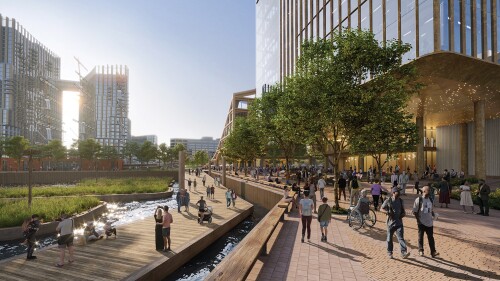Cities are recognizing the risks associated with rising water levels, natural disasters, and potential epidemics. Sustainability is now an accepted part of the development “ethos” in real estate, along with increased efforts toward urban resilience. During ULI Washington’s recent Real Estate Trends event, panelists discussed the business case for employing sound methods and practices to create healthier, safer building environments.
Helen Gurfel, executive director of the ULI Greenprint Center, kicked off the session with an update on Greenprint’s achievements. Over the last six years alone, the initiative has enrolled more than 5,400 properties comprising a total of 1.3 billion square feet (121 million sq m) of space in 39 countries. This portfolio has reduced its carbon emissions by 16.5 percent, with similar reductions in energy, electricity, and water use. Greenprint’s goal is to help reduce buildings’ greenhouse gas emissions by 50 percent by 2030.
Cities, home to 50 percent of the world’s population, produce 70 percent of global carbon emissions, noted Tommy Wells, director of the Department of Energy and Environment for Washington, D.C. “Cities are both the problem and solution for global climate change,” he said. “The last three years were the hottest in history, and heat is having a great impact on the city. To help cool the city, we have added more green roofs per year in the last three years than any other city, and we are trying to increase our tree canopy to 40 percent.” In addition to providing cooling effects, this greenery helps manage stormwater.
Along with many other urban centers, Washington is experiencing increasing flooding. “When we look at building codes, the 100-year floodplain no longer applies,” he said. “Instead, we are now looking at 500-year floodplains the way we used to with 100-year areas.” Other cities, he added, are out even further; Copenhagen is looking at a 10,000-year flood zone.
The District is also rethinking its part of the national electric grid. “The cost of solar power has dropped so low that we now need to rule it out rather than worrying about the cost of adding it,” he said. “We can add solar power vertically, not just horizontally, and use batteries to cut peak capacity.” Washington just passed “Solar for All” legislation expected to generate half a billion dollars over the next 15 years to invest in community solar energy and battery use. The city is also looking at district energy, such as extracting the constant water temperature of a large sewage pumping station.
Jon Penndorf of Perkins + Will, who worked on a major study for the District of Columbia government, said that sustainability and wellness are major trends in building design. “The nation loses $153 billion annually in reduced productivity due to chronic illness,” he explained. “Wellness is positioned to become the next trillion-dollar industry. It’s not just about the building not making you sick, but also about it helping make you well. We spend up to 90 percent of our time indoors, and the quality of that indoor environment is responsible for 20 percent of your health.”
Resilient building design has three major impacts on the business bottom line, Penndorf explained. Economic benefits include reduced insurance premiums and a lower cost to bounce back from disasters. Social benefits include the health and well-being of occupants and surrounding communities. Environmental benefits include reducing pollution and waste along with mitigating certain climate events.
To help building owners measure the costs and benefits of building more healthy structures, a number of new guidelines and standards are available or under development, Penndorf went on. New York City’s Active Design Guidelines include such factors as placement of stairs. The aggressive WELL building standard applies to new construction, while Fitwel helps gauge what buildings are doing right now to support wellness. The RELi resilience checklist is similar to the Leadership in Energy and Environmental Design (LEED) program by identifying actionable measures to increase resilience, protect occupants’ health and safety, and preserve property.
As the movement to increase buildings’ sustainability and resilience advances, who will pay? Joining the ULI panel was Chrissa Pagitsas, director of Fannie Mae’s Green Financing Business. Fannie Mae, Freddie Mac, and the U.S. Department of Housing and Urban Development collectively handle half of multifamily debt in the United States. Fannie’s green business initiative kicked off seven years ago, and last year issued $3.6 billion in “green” bonds. “Green is no longer a side act or afterthought but the act,” she said. Fannie now offers three products:
- Green Rewards: a lower-priced mortgage loan that pays for energy audits and the green retrofitting of existing multifamily buildings.
- Green building certifications: Fannie provides lower interest rates on loans to multifamily properties that have certifications such as LEED or Energy Star.
- Green Preservation Plus: Larger loans focusing on the affordable housing market.
The Fannie Mae program includes tracking and quantifying results. For example, multifamily property owners using Fannie Mae’s green financing save an average of $35,000 per year on energy and water use. However, Fannie does not yet offer financing options tied to residents’ health. Remarked Pagitsas: “There are many options, but few standard ones.”




